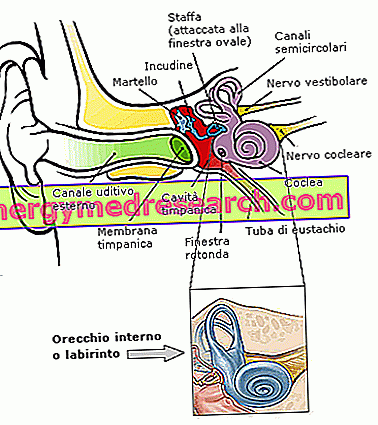What is labyrinthitis?
Labyrinthitis is defined as an inflammation of the labyrinth and other internal structures of the ear; it is an alteration of the unilateral vestibular function.
Before proceeding with the analysis of the labyrinthitis, let us briefly recall that the labyrinth corresponds to a small inner auricular portion, consisting of organs used for maintaining balance and listening to words and music. The labyrinth, containing the ear nerve, is normally filled with a fluid (endolymph) that detects the slightest movements of the head: if the brain receives the order to rotate or move the head, the liquid contained within the labyrinth will it moves, thus stimulating the nerve of the inner ear.

It should be pointed out that labyrinthitis is not synonymous with vertigo: often, in fact, these two terms are mistakenly mistaken as equivalent; in reality, vertigo is a common symptom of many diseases, while labyrinthitis is recognized as a disease in all respects.
Causes
A precise and unambiguous cause responsible for the labyrinthitis has not yet been isolated; however, it is assumed that the disease is the end result of bacterial or viral insults, such as mumps and acute otitis: an infection of the upper respiratory tract could spread to reach the level of the inner ear . In the etiopathological research of labyrinthitis, head injuries, violent allergic reactions to a drug (especially antibiotics) or to another substance, and extreme stress are also attributable.
In general, the labyrinthitis manifests itself in its serous variant, as a result of the passage of bacteria or toxins through an ear canal (perilymphatic fistula of the lateral semicircular canal): in this case, the patient suffering from labyrinthitis complains of vertigo of variable intensity, generally temporary and occasional. It has been observed that some factors or situations can predispose the patient to undergo attacks of labyrinthitis: a particularly violent cough, an abrupt movement or, again, an effort carried to excess, can constitute elements of risk for the manifestation of the crises of labyrinthitis, especially in predisposed subjects.
Following meningitis or meningoencephalitis, the labyrinthitis can also manifest itself in the purulent variant, responsible for the progressive and inevitable damage to the internal structures of the labyrinth: in this case, the symptoms, always sudden, take the form of loss of balance and functionality of the vestibular system in general, and in the disappearance of hearing ability. The hearing deficit is unfortunately irreversible and almost always total.
Symptoms
To learn more: Symptoms Labirintite
Labyrinthitis begins with a generally acute and violent symptomatology, in which vertigo is the common element in all patients who are affected. A patient with labyrinthitis complains of anxiety, confusion, difficulty maintaining balance, ringing in the ears (tinnitus), dizziness, nausea, nystagmus, stomach pain, pallor and hearing loss.
These symptoms derive essentially from a sudden incapacity of the vestibular system to ensure equilibrium to the organism: we are witnessing a blockage of the regulation of this complex system, implicated precisely in the detection of the change of motion of the person. Not surprisingly, all the symptoms listed above can occur, albeit to a lesser extent, even during a trip by plane, ship or dive.
Psychological reflexes
In most cases, patients suffering from labyrinthitis are anxious and frightened by the disease, feeling unable to control themselves: the anxiety syndrome is a very common symptom in the context of labyrinthitis, responsible for the manifestation of panic attacks, depression, palpitations and tremors, which certainly do not benefit the disease in progress, rather aggravate the problem by prolonging healing times. Not surprisingly, panic attacks are some of the very first symptoms that occur almost at the same time as the labyrinthitis crisis.
While vertigo may appear in the case of particularly severe anxiety, but without precipitating more complex disorders, labyrinthitis can lead to serious problems, such as depression and panic attacks.
Diagnosis
It is recommended to contact the specialist from the earliest symptoms, to start the possible pharmacological treatment in a short time; the doctor, after tracing the patient's medical history, proceeds with the physical examination, useful for ascertaining whether the dizziness and the sensation of loss of balance are due to a problem of the vestibular system and the labyrinth. In some cases, patients are subjected to specific tests, useful for inducing vertigo: although this examination is not accepted benevolently by patients, it is often indispensable for diagnostic purposes.
The assessment of the diagnosis proceeds by subjecting the affected patient to a series of more or less complex tests; the choice of the test clearly depends on the intensity of the symptoms and the difficulty in ascertaining the disease. Among the most widespread tests, we recall:
- Test of auditory response of the stem-brain: this test, which consists in the application of special earphones to the patient in which some sounds or words are reproduced, is useful for verifying the patient's response to stimuli.
- Electronistagmography: this diagnostic test is used to analyze vestibular disorders and is useful for analyzing further, inability to control balance. The technique uses electrodes that are placed around the eyes and on the forehead of the patient; in turn, these electrodes are connected with an apparatus, which amplifies and records the voluntary ocular motion, induced by several factors (light stimulation, sensory, positioning, etc.)
- Bacterial culture test: since labyrinthitis is often caused by bacteria, the culture test is essential to identify the pathogen responsible for the disease
- CT scan (computerized axial tomography): the patient undergoes a CT scan, a radiological diagnostic test in which ionizing radiation is used to obtain detailed images of the patient's skull
- MRI (magnetic resonance tomography): this diagnostic test is used to reproduce brain images, including capillaries and head structures. From the result it is possible to detect any cerebral lesions associated with the labyrinthitis.
Medications and treatments
To learn more: Drugs to cure labyrinthitis
Treatment for the treatment of labyrinthitis depends on the cause and the severity of the condition; the goal of therapy is to prevent, lighten and resolve the signs and symptoms that accompany the disorder. When labyrinthitis depends on a bacterial insult, antibiotics are the most widely used drugs in therapy, while antivirals (eg acyclovir, valaciclovir) are indicated to break down the virus: reflex pathogen removal also involves healing labyrinthitis (mild form). Furthermore, since the disease is accompanied by dizziness and loss of balance associated with nausea and vomiting, anti-emetic drugs can be a valid aid; there are also specific drugs to control vertigo: these active ingredients are indispensable to eliminate the feeling of loss, to relax and to calm the patient who is affected. Anticholinergic drugs (eg prochlorperazine) are the most used for this purpose. Steroids (eg prednisone) are occasionally prescribed to reduce inflammation, especially in cases of proven viral labyrinthitis.
Furthermore, we have seen that labyrinthitis is often closely linked to anxiety and depression disorders: for this reason, it is possible to take specific drugs, such as benzodiazepines (eg diazepam) and selective serotonin reuptake inhibitors. It is recommended to respect the doses prescribed by the doctor and not to interrupt the treatment suddenly.
Clinical evidence shows that SSRIs are particularly useful in alleviating the symptoms that accompany labyrinthitis, as well as speeding up healing.
When the drugs are not sufficient to ensure a definitive cure, the patient can undergo invasive treatments, such as surgery: this technique corrects some damage to the ear and the head, which in turn are implicated in the appearance of the labyrinthitis.
As a completion of the labyrinthitis therapy, it is possible to direct the patient towards the so-called "vestibular rehabilitation", which essentially consists of specific exercises aimed at improving balance and removing vertigo.
It is recommended to start the therapy as soon as possible from the diagnostic assessment of labyrinthitis: in this way, it is possible to avoid permanent damage to the ear.



